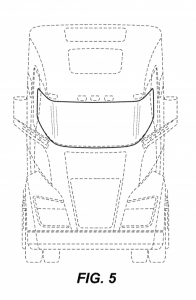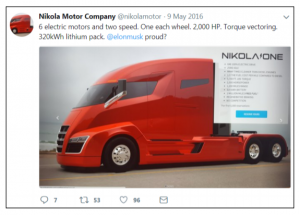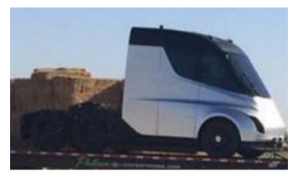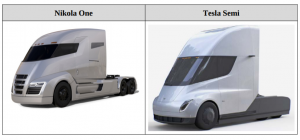 On April 30th, alternative fuel vehicle manufacturer Nikola Corporation filed a complaint alleging claims of design patent infringement against electric vehicle maker Tesla Inc. Filed in the District of Arizona, Nikola’s complaint accuses Tesla of copying various elements of design patents held by Nikola in the area of heavy duty semi truck cabin design.
On April 30th, alternative fuel vehicle manufacturer Nikola Corporation filed a complaint alleging claims of design patent infringement against electric vehicle maker Tesla Inc. Filed in the District of Arizona, Nikola’s complaint accuses Tesla of copying various elements of design patents held by Nikola in the area of heavy duty semi truck cabin design.
Nikola is asserting three design patents in this case:
- U.S. Patent No. D811944, titled Fuselage and issued to inventors Trevor Milton and Steve Jennes this March.
- U.S. Patent No. D811968, titled Wrap Windshield and also issued in March to Milton and Jennes.
- U.S. Patent No. D816004, titled Side Door and issued to Milton and Jennes this April.
 Nikola’s complaint notes that Milton began designing the Nikola One electric vehicle semi truck beginning in 2013 with the aim of reducing fossil fuel emissions in the trucking industry, especially for Class 8 trucks which contribute about 7 percent of worldwide greenhouse gases. In 2015, Milton hired Jennes, a vehicle designer with 25 years of industry experience, and the pair developed the Nikola One incorporating the innovative designs covered by the design patents in such a way that enabled the Nikola One to have a distinguishable design which could be recognized from half-a-mile away. The design elements also gave drivers an unobstructed view of the road, easier and safer access to the vehicle cabin and increased cabin volume by about 30 percent while reducing the drag coefficient. “By the time Nikola filed its patent applications, it had spent several million dollars developing the Nikola One,” Nikola’s complaint reads.
Nikola’s complaint notes that Milton began designing the Nikola One electric vehicle semi truck beginning in 2013 with the aim of reducing fossil fuel emissions in the trucking industry, especially for Class 8 trucks which contribute about 7 percent of worldwide greenhouse gases. In 2015, Milton hired Jennes, a vehicle designer with 25 years of industry experience, and the pair developed the Nikola One incorporating the innovative designs covered by the design patents in such a way that enabled the Nikola One to have a distinguishable design which could be recognized from half-a-mile away. The design elements also gave drivers an unobstructed view of the road, easier and safer access to the vehicle cabin and increased cabin volume by about 30 percent while reducing the drag coefficient. “By the time Nikola filed its patent applications, it had spent several million dollars developing the Nikola One,” Nikola’s complaint reads.
 The Nikola One was introduced to the public on May 9th, 2016, when Nikola issued a press release describing the Class 8 semi-truck and published images of the Nikola One online. By the middle of June, Nikola had already received 7,000 pre-orders for the Nikola One, representing $2.3 billion in value. After an unveiling event for the Nikola One in December, the value of pre-order reservations for the truck increased to $4 billion. As of the time of its complaint, Nikola had received more than $6.3 billion in pre-order revenues with plans for the Nikola One semi to enter production in 2020.
The Nikola One was introduced to the public on May 9th, 2016, when Nikola issued a press release describing the Class 8 semi-truck and published images of the Nikola One online. By the middle of June, Nikola had already received 7,000 pre-orders for the Nikola One, representing $2.3 billion in value. After an unveiling event for the Nikola One in December, the value of pre-order reservations for the truck increased to $4 billion. As of the time of its complaint, Nikola had received more than $6.3 billion in pre-order revenues with plans for the Nikola One semi to enter production in 2020.
The first time that Tesla mentioned any work on developing a heavy duty semi truck came on July 20th, 2016, when Tesla CEO Elon Musk unveiled a new “master plan” for the company which included early stage development on a semi truck. This updated master plan was issued a few weeks after Tesla released earnings figures showing that the company had experienced a net loss of $575 million through the first half of 2016. On September 22nd, 2016, a Tesla representative allegedly contacted Kevin Lynk, Nikola’s chief engineer, to see if Lynk was interested in joining Tesla’s truck development team, but Nikola didn’t respond to the invitation.
 In April 2017, Musk tweeted about the Tesla Semi and produced a picture teaser of the Semi’s silhouette at a public interview. In October of that year, a picture of a supposed Tesla Semi appeared in the public online forum Reddit featuring elements identified by Nikola in a November letter to Tesla as potentially infringing the design patents which were being prosecuted at that time. About a week after Nikola sent that letter, Tesla held a public unveiling event for the public semi and by mid-December, Tesla had reportedly accepted about 1,200 pre-orders for the Semi. “Upon information and belief, at full value, Tesla’s orders are worth over $215 million,” Nikola’s complaint reads.
In April 2017, Musk tweeted about the Tesla Semi and produced a picture teaser of the Semi’s silhouette at a public interview. In October of that year, a picture of a supposed Tesla Semi appeared in the public online forum Reddit featuring elements identified by Nikola in a November letter to Tesla as potentially infringing the design patents which were being prosecuted at that time. About a week after Nikola sent that letter, Tesla held a public unveiling event for the public semi and by mid-December, Tesla had reportedly accepted about 1,200 pre-orders for the Semi. “Upon information and belief, at full value, Tesla’s orders are worth over $215 million,” Nikola’s complaint reads.
Revenues from Tesla Semi pre-orders have buoyed the company during some tough financial events, Nikola notes. Tesla’s continued inability to meet production deadlines set by Musk have contributed to significant declines in Tesla’s stock price and a $619 million quarterly loss reported last November. When Tesla unveiled the Semi, the corresponding rise in Tesla’s stock price added $2 billion to Tesla’s market value. “In other words, the market believed the Tesla Semi was worth roughly $2 billion in discounted future profits to Tesla,” the complaint reads.
 Nikola alleges that the Tesla Semi is substantially similar to the Nikola One, which embodies the three design patents asserted in the case. Tesla’s incorporation of the patented fuselage design into the Tesla Semi has enabled it to achieve a drag coefficient similar to the Nikola One, both of which feature drag coefficients which make them more aerodynamic than the Bugatti Chiron. Tesla has also touted the Tesla Semi’s ability to give drivers a panoramic view of the road and their surroundings with the wrap windshield, a feature which is not found on other Class 8 semi trucks and infringes Nikola’s ‘968 design patent. No other truck in the semi industry other than the Tesla Semi includes the mid-entry door which is covered by Nikola’s ‘004 design patent.
Nikola alleges that the Tesla Semi is substantially similar to the Nikola One, which embodies the three design patents asserted in the case. Tesla’s incorporation of the patented fuselage design into the Tesla Semi has enabled it to achieve a drag coefficient similar to the Nikola One, both of which feature drag coefficients which make them more aerodynamic than the Bugatti Chiron. Tesla has also touted the Tesla Semi’s ability to give drivers a panoramic view of the road and their surroundings with the wrap windshield, a feature which is not found on other Class 8 semi trucks and infringes Nikola’s ‘968 design patent. No other truck in the semi industry other than the Tesla Semi includes the mid-entry door which is covered by Nikola’s ‘004 design patent.
Nikola alleges that Tesla’s marketing of its infringing semi truck has created confusion in the marketplace. Nikola cites to a couple of online news reports discussing the Tesla Semi but showing pictures of the Nikola One. The firm also notes coverage that has compared both the Tesla and Nikola trucks and noted several similarities between the two models. Consumer confusion leading to sales diverted from Nikola to Tesla will harm Nikola economically, including an increase in the cost of building hydrogen fueling stations for Nikola Ones and weakened consumer perception because of limitations in the Tesla Semi; the Tesla Semi has a 500-mile range compared to Nikola One’s maximum range of 1,000 miles, and charging times for the Tesla Semi are up to 15 minutes longer than the Nikola One’s charging time.
Anyone who has followed the Musk’s statements on patents over the past few years must be acutely aware of a rich irony to this lawsuit that extends beyond the namesake shared by both companies in this case. In June 2014, Musk authored a Tesla blog post where he said that his business experience had taught him that a patent was simply “a lottery ticket to a lawsuit.” Indeed, if Tesla were to have its own design patents covering any part of the Tesla Semi design, that would be one of the stronger defenses it could raise to counter Nikola’s suit. The way that Tesla comports itself during this patent infringement case should shed some great light on Musk’s actual philosophy regarding patents.

![[IPWatchdog Logo]](https://ipwatchdog.com/wp-content/themes/IPWatchdog%20-%202023/assets/images/temp/logo-small@2x.png)

![[Advertisement]](https://ipwatchdog.com/wp-content/uploads/2024/04/Patent-Litigation-Masters-2024-sidebar-early-bird-ends-Apr-21-last-chance-700x500-1.jpg)

![[Advertisement]](https://ipwatchdog.com/wp-content/uploads/2021/12/WEBINAR-336-x-280-px.png)
![[Advertisement]](https://ipwatchdog.com/wp-content/uploads/2021/12/2021-Patent-Practice-on-Demand-recorded-Feb-2021-336-x-280.jpg)
![[Advertisement]](https://ipwatchdog.com/wp-content/uploads/2021/12/Ad-4-The-Invent-Patent-System™.png)







Join the Discussion
2 comments so far.
Paul Morgan
May 18, 2018 03:44 pmMaking functional arguments like “the aim of reducing fossil fuel emissions” and “unobstructed view of the road, easier and safer access to the vehicle cabin and increased cabin volume by about 30 percent while reducing the drag coefficient” in support of mere design patents is one of several things frequently erroneously confused re what design patents are for, what they protect, and how they should be 103 analyzed.
Raymond Van Dyke
May 17, 2018 01:55 pmNikola v. Tesla!